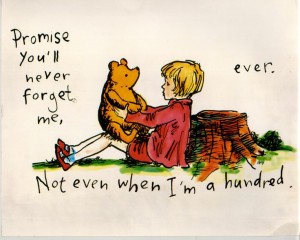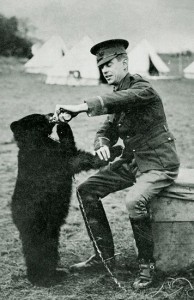Winnie the Pooh – A Real Bear with a WWI Story
 It may surprise you to know that the lovable bear, Winnie the Pooh, is actually based on a real bear. A Canadian bear actually, with a direct link to World War I.
It may surprise you to know that the lovable bear, Winnie the Pooh, is actually based on a real bear. A Canadian bear actually, with a direct link to World War I.
Harry Colebourn
Harry Colebourn is the man who we ultimately have to thank for introducing the writer AA. Milne, the author of the famous Winnie the Pooh books, to a bear called Winnie. That introduction occurred via a very circuitous route and was a result of empire, emigration and World War I.
Harry was born in England in 1887. He emigrated to Canada when he was 18 where he attended the Ontario Veterinary College, receiving his degree in veterinary surgery, before moving out west to Winnipeg, Manitoba.
When war broke our between Britain and Germany he volunteered. As a veterinary surgeon he would have been in high demand with armies in the field at this time, still relying upon animals to bear the brunt of much of the transport and supply.
Winnie the Bear
It was whilst Harry was heading across Canada by train to the training camp at Valcartier in Quebec that he came across a hunter in White River, Ontario who had a female black bear cub for sale, having killed the cub’s mother. Colebourn felt sorry for the orphaned cub and purchased her for $20. He named her “Winnie” after his adopted home town.
When it came time to depart for overseas service Harry must have somehow persuaded the military authorities to let him take Winnie with him. For it was a newly commissioned Lieutenant Colebourn that turned up for duty on Salisbury Plain in southern England complete with black bear in tow. Winnie soon became the unofficial mascot of the Fort Garry Horse, a militia cavalry regiment to which Harry had been assigned as a veterinarian.
When the time came to en-train for France he left his beloved Winnie at London Zoo for safekeeping. Harry served for three years in France, attaining the rank of Major. He planned to take her home with him but instead, at the end of the war he donated Winnie to London Zoo, in recognition for the care she had had over the previous war years.
A. A. Milne
- The ‘Woozle effect’ is the phenomenon whereby an urban myth gains currency through being repeated; the term derives from Winnie-the-Pooh.
- Winnie the Pooh’s real name is Edward Bear.
- Winnie’s Latin translation is the only Latin book to ever crack The New York Times Best Seller list.
- Winnie the Pooh movies and merchandise makes Disney just as much money as from the same creations bearing Mickey, Minnie, Donald, Goofy and Pluto.
It was at the London Zoo that A. A. Milne and his son Christopher Robin encountered Winnie. Christopher was so taken with her that he named his teddy bear after her, which became the inspiration for Milne’s fictional character in the books Winnie-the-Pooh (1926) and The House at Pooh Corner (1928).
Milne also included several poems about Winnie-the-Pooh in his children’s poetry books When We Were Very Young and Now We Are Six
Winnie remained at the zoo until her death in 1934.
I think it’s called love.
― A.A. Milne, Winnie-the-Pooh
but I do nothing every day.
― A.A. Milne, Winnie-the-Pooh
“It’s today,” squeaked Piglet.
“My favorite day,” said Pooh.”
― A.A. Milne, Winnie-the-Pooh


















You must be logged in to post a comment.